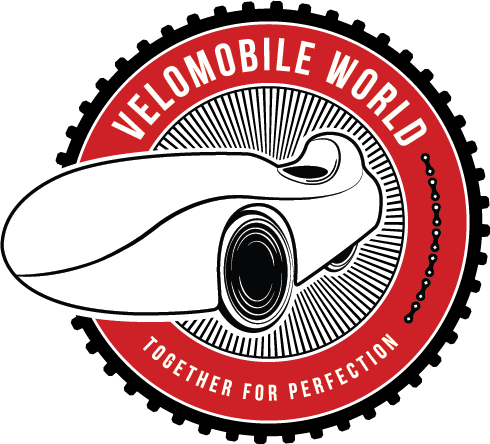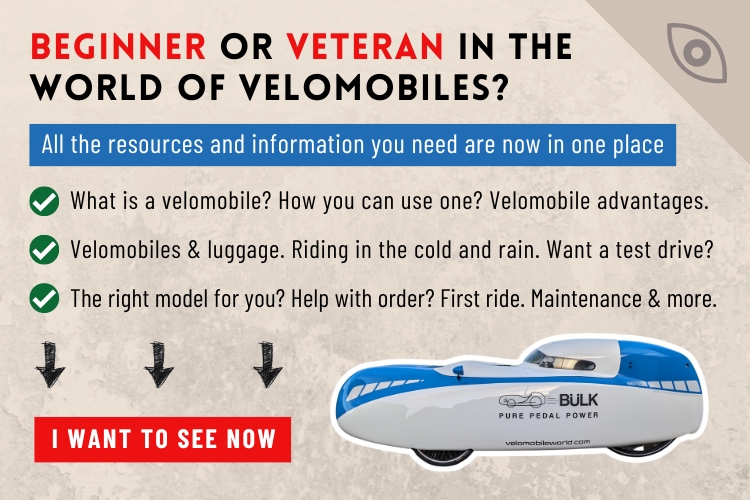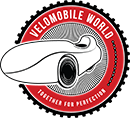......................................................
STORIES FROM VELOMOBILE COMMUNITY
Velomobiles are Expensive!
Author: BEN PARKE
......................................................


......................................................
I’ve been intrigued by the idea of a velomobile for a while. It seemed ideal for riding in the harsh Minnesota winters, but the price tag? $5,000 or more just for a used one?!? I wouldn’t call myself cheap per se, but to me that was expensive for something I would be using for a weekend ride or two in the cold, especially since I’d never spent more than $2,000 on a bike.
I like to build things. In online forums I ran across some people who had built coroplast shells for trikes. I got a good deal on a Trice T trike and started building a shell. The resulting creation was…uh, interesting? Yes, it made the trike somewhat faster, but not any faster than my fastest 2-wheeled recumbent. It was awkward to get in and out of and looked…ridiculous. Not one to be dissuaded by a poor result, I decided to try building a proper velomobile. I mean, it’s just a composite shell with bicycle parts. How hard can that be? And it had to cost less than buying a used velomobile.
They say innocence is bliss. After consulting extensively with YouTube on how to build cedar strip kayaks, I set to work building a shell out of cedar strips. A month later, the shell was complete. I started the project in September and figured I’d be done by Thanksgiving. Thanksgiving came and went and I most definitely was not done. But surely it would be done by Christmas. Then I ran into some issues setting up the steering and aligning the drivetrain and found the front of the cockpit was too far towards me. After some significant modifications and a lot of frustration, I finally got the cedar velomobile on the road. It was now mid-April.
I did some riding in it over the course of the summer, but at 90+ pounds it wasn’t the best riding experience. After discovering how bad my open wheel wells were aerodynamically, I decided to rebuild a bunch of the front end with carbon fiber.
By the following Christmas, the temptation to get a commercially built velomobile lead to me gifting myself a 10 year old Quest XS for Christmas. I told myself I’d use it to guide me in improving my homebuilt velomobile and then sell the Quest..
The Quest was so much lighter, so much faster, so much better built. I always wondered why velomobile riders almost never rode their unfaired bikes. The Quest cleared that question up for me. Trouble is, it left me wanting something even better. I wanted better airflow and lighter weight. Better stiffness and efficiency. When the opportunity came along to get a Bülk, I placed an order.
Between the build costs of the cedar strip velomobile and the purchase cost of the Quest XS, I had now managed, in my budget minded approach, to invest roughly the same amount as a new Bülk.
So why are velomobiles so expensive to build? Nearly everything is made of carbon fiber which is laid up by hand in molds made by hand from plugs made by hand. The materials to make the shell are not exactly cheap, especially the epoxy resin. It has to cure in highly controlled conditions, and even painting is labor intensive. The small pinholes left in the resin matrix have to be filled with putty and then everything is sanded perfectly flat in order to get a smooth aerodynamic finish. The paint process takes nearly a week. Then there is the installation of the interior parts where everything needs to be perfectly aligned. The whole build process can take as much as 6 weeks, at least if you want it done right.
Of course it would be great if velomobiles could be built and sold for a lower price. What I’ve learned from my own build process is that there are compromises that have to be made in efficiency and driving enjoyment in a budget build. Some efforts to produce a robust and inexpensive velomobile have been made. An Australian company offers a rotational molded velomobile that’s virtually indestructible. It’s also over 70 lbs, and not particularly fast. There are a few in the US that show up for sale used every year as their owners upgrade to a more efficient model or give up riding velomobile altogether. Then there are fiberglass velomobiles which can run 80 or more lbs. Fiberglass is cheap but not known for its stiffness. That means the effort you put into pedaling is not all transferred to the drivetrain. Heavy and flexible also means poorer acceleration and climbing, both of which can cost a lot of time in a commute and also suck a lot of the joy out of riding. Lower production cost would also impact the quality of drivetrain parts and assembly accuracy. Cheaper shifters and derailleurs don’t operate as precisely as was the case with my first recumbent bike. Assembly done by less skilled labor also can lead to poorly aligned drivetrains and bad steering action and handling, assuming those things were even designed well in the first place. That all adds up to a mediocre ride experience and could lead a lot of potential riders to decide velomobiles are not for them, not to mention safety concerns from failed parts.
Remember how I said I wanted a velomobile for something to ride for fun on weekends? Turns out I enjoy riding the Bülk so much that I’ve started commuting and running all of my errands with it. In fact, what I had intended to be a weekend toy, has now replaced my car.
Let’s talk about cars for a moment. AAA does a yearly study on the average cost of owning a car. For 2023 in the USA, that cost is…$12,182 based on driving 15,000 miles. That factors in depreciation, gas, maintenance, taxes, registration, insurance, and loan payments. Obviously these figures will vary based on the car and driver, but comparing that yearly cost to the purchase price of a velomobile gives some perspective. Yearly maintenance on a velomobile will run around $100 for a nice set of Contact Urban tires and a bottle of chain lube. Maybe every other year you buy a new chain, about $120. There are no yearly registration fees or taxes and no insurance requirement. Velomobiles also tend to hold value longer than cars. Obviously it’s going to be hard to haul your family around in a velomobile, but a family could potentially replace at least one vehicle with a velomobile. Based on the number of single-occupant vehicles on the road, there appears to be an opportunity here for quite a few people.
There are other potential savings from switching to a velomobile too. The average healthcare costs in the USA at $12,000 per year, is roughly the same as owning a car. The biggest health issues in the USA currently are heart disease, cancer, opioids, obesity, and lower respiratory diseases. Cycling may not cure all of these things, but it sure can help. I’ve found I’m more motivated to eat healthier, I sleep better, and I’m more productive and happier since commuting by velomobile. Some people may also find riding velomobile eliminates the need to have a gym membership, potentially saving another chunk of cash.
The final savings I’ve found has been time. Yes, cycling everywhere takes longer, but I was already spending 45-60 minutes a day exercising. Now that time is rolled into my commute.
Now, you could also just buy a cheap bike and commute with that, and for people in milder climates that is a legitimate option. For me a velomobile, despite being a bigger investment, made the most sense. I like the weather protection, the greater efficiency, the fact that carrying cargo doesn’t impact aerodynamics, and the enhanced safety and visibility from the shell.
That said, there are people who have built their own velomobile and are sufficiently happy with the result. For some they are simply looking for weather protection and can live with the compromises in performance. For me it wasn’t until I had a Bülk that the performance level was close enough to a car for me to go car-free.
So yes, velomobiles like a lot of things these days are expensive, but the quality you get for the investment is significant and something I think is worth saving for. In the long run you’ll earn a large part of that investment in savings on transportation expenses. It took me a lot of time and money to appreciate the design and construction complexity of a velomobile. While I would have preferred not to learn the hard, expensive way, I definitely can appreciate the quality of a commercially built velomobile a lot more.
As always, if you’re interested in learning more about velomobiles, click the link in the description where you can find information about the velomobile I ride and contact me for help setting up a test ride and getting your own velomobile. As always, thanks for watching, ride safe, remember to like and subscribe, and I’ll see you in the next video.







